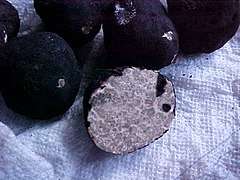Leucangium carthusianum
Leucangium carthusianum is a species of ascomycete fungus. It is commonly known as Oregon black truffle. It is found in the Pacific Northwest region of North America, where it grows in an ectomycorrhizal association with Douglas-fir. It is commercially collected, usually assisted by a specially trained truffle dog.[1] Mature fruiting bodies can be dug up mostly during winter, but the season can extend from September through April.
| Leucangium carthusianum | |
|---|---|
 | |
| Leucangium carthusianum | |
| Scientific classification | |
| Kingdom: | |
| Division: | |
| Class: | |
| Order: | |
| Family: | |
| Genus: | |
| Species: | L. carthusianum |
| Binomial name | |
| Leucangium carthusianum (Tul. & C.Tul.) Paol. (1889) | |
| Synonyms | |
| |
Edibility
Leucangium carthusianum is a good edible mushroom;[2] it can be prepared similarly to Oregon White and European truffles; it is typically shaved raw on top of a dish to add its complex musky aroma, dominated by a fruity, pineapple-like odor.[1]
gollark: ++exec```pythonprint("hi")```
gollark: ++exec```pythonprint("hi")```
gollark: ++exec```pythonprint("hi")```
gollark: ++exec```pythonprint("hi")```
gollark: ++exec```pythonprint("hi")```#
References
- Winkler, Daniel (2013). "Truffles of the Pacific Northwest". Fungi. 6 (4): 16–19.
- Phillips, Roger (2010). Mushrooms and Other Fungi of North America. Buffalo, NY: Firefly Books. p. 376. ISBN 978-1-55407-651-2.
External links
This article is issued from Wikipedia. The text is licensed under Creative Commons - Attribution - Sharealike. Additional terms may apply for the media files.